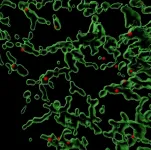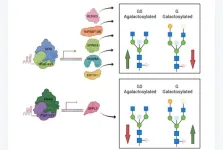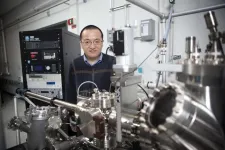(Press-News.org) MADISON – Like mail carriers who manage to deliver their parcels through snow, rain, heat and gloom, a critical group of mammalian proteins helps cells function properly even under less-than-ideal conditions.
Using state-of-the-art cell imaging and genome editing technology, University of Wisconsin–Madison scientists have begun to unravel how this collection of proteins performs its essential service. The discovery could eventually help researchers better understand and develop new treatments for diseases like cancer, diabetes and those that cause immune dysfunction.
Led by Anjon Audhya, a professor in the Department of Biomolecular Chemistry, the research team sought to better understand how the Coat Protein Complex II, or COPII, functions. COPII is an enormously important group of proteins responsible for transporting roughly a third of all proteins that function in mammalian cells.
COPII was a subject of the 2013 Nobel Prize in Physiology or Medicine, which was awarded to a trio of scientists for their work defining how proteins are sorted and transported around cells. This new research builds on some of those discoveries.
There are millions of proteins inside mammalian cells, and they perform a wide variety of duties. Cells must ensure that proteins are moved efficiently to their proper places, so they can perform their cellular roles — an intricate task requiring precision. Previous research identified COPII as an essential part of this process, but no one had recorded exactly how this set of proteins goes about packaging and transporting other proteins around cells.
To do so, Audhya and his colleagues used the CRISPR/Cas9 genome editing tool to add a tag, which could be chemically linked to a bright, fluorescent dye, to individual proteins involved in controlling the traffic flow within cells, including some that make up the COPII complex. With the tag, the scientists could follow the proteins as they moved about living cells.
Using a technique called lattice light-sheet imaging, the team tracked how COPII helps get cellular proteins, including molecules destined for other places, where they're supposed to go — something that had never been done before.
The team described their advance in a paper recently published in the journal Nature Communications. Audhya described it in terms of the postal system. Researchers knew that COPII functions like postal workers who pick up and deliver parcels, but they had never tracked these workers as they sorted packages through the cell's distribution and delivery systems.
"We can now see that envelope in the mailbox, see how the mail carrier comes to the mailbox to pick up the letter and then drive away," says Audhya, who is the senior associate dean for basic research, biotechnology and graduate studies at the School of Medicine and Public Health.
The researchers discovered that, on average, this delivery process takes between 45 and 60 seconds under normal conditions. However, when cells receive subpar nutrition, as they sometimes do thanks to certain diseases and environmental conditions, this process slows down significantly, at least until cells can adapt over time.
Through a series of experiments, Audhya and his colleagues were able to identify a single protein named Sec23 that was capable of helping restore COPII's trafficking system after disruption. When the scientists increased how much Sec23 was produced inside cells, they saw a change in the rate in which cells transported proteins, “something we never anticipated when we started this work," Audhya says. "Sec23 seems to be the central player in regulating the function of the COPII complex.”
Identifying what triggers Sec23 to promote COPII function has potential implications for a number of diseases. For instance, cancer cells often grow prodigiously in nutrient-starved environments, in part by producing more of certain proteins that promote growth. Understanding the molecular mechanisms that underlie this property could identify new targets for therapies.
Beyond that, a more precise picture of the process by which cells correctly prepare and deliver proteins can help inform our basic understanding of proper cell function and what can go awry in diseases such as cancer, Type 2 diabetes, neurodegenerative conditions and immune disorders.
"Understanding these fundamental processes and the regulatory systems that exist in cells can ultimately pave the way to developing more rational approaches to disease intervention," says Audhya.
This work was supported in part by National Institutes of Health grants GM134865 and GM008688, as well as shared resources available in the UWCCC Flow Cytometry Laboratory and the UW Optical Imaging Core.
# # #
--Will Cushman, wcushman@wisc.edu, 608-263-1986
END
“[...] we were able to confirm the functional role of three genes (MANBA, TNFRSF13B and EEF1A1) in the IgG galactosylation pathway [...]”
BUFFALO, NY- January 3, 2024 – A new research paper was published in Aging (listed by MEDLINE/PubMed as "Aging (Albany NY)" and "Aging-US" by Web of Science) Volume 15, Issue 24, entitled, “Mapping of the gene network that regulates glycan clock of ageing.”
Glycans are an essential structural component of immunoglobulin G (IgG) that modulate its structure and function. However, regulatory mechanisms behind this complex posttranslational ...
DURHAM, N.C. – If you have a deep-seated, nagging worry over dropping your phone in molten lava, you’re in luck.
A research team led by materials scientists at Duke University has developed a method for rapidly discovering a new class of materials with heat and electronic tolerances so rugged that they that could enable devices to function at lava-like temperatures above several thousands of degrees Fahrenheit.
Harder than steel and stable in chemically corrosive environments, these materials ...
FOR IMMEDIATE RELEASE
Care for patients with human papillomavirus (HPV)-related squamous cell cancers of the oropharynx (an area in back of the throat) is shifting toward community cancer centers, but patients treated in this setting may be less likely to survive, according to new research by investigators from the Johns Hopkins Kimmel Cancer Center and its Head and Neck Cancer Center.
The study, published Jan. 3 in the Journal of the National Cancer Institute, raises concerns about the quality of care that patients with this type of head and neck cancer receive outside of academic medical centers. Patients treated ...
INDIANAPOLIS—A beta blocker typically used to treat heart problems, hemangioma, migraines and anxiety could be a new therapeutic for patients with sickle cell disease. Researchers led by Ankit A. Desai, MD, associate professor of medicine at the Krannert Cardiovascular Research Center (KCVRC) at Indiana University School of Medicine, have been awarded a $3 million grant by the U.S. Department of Defense to evaluate the efficacy of this drug.
Patients with sickle cell disease, a red blood ...
Cleveland Clinic and the University of Western Ontario have been awarded a $4.9 million grant from Helmsley Charitable Trust to build a consortium to develop clinical trial outcome tools for patients with Crohn's disease and permanent ileostomy.
A permanent ileostomy is a surgical procedure to divert stool from the intestine after removing part of or the whole colon. The new Endpoint Development for Ostomy Clinical Trial (EndO-trial) Consortium seeks to develop more effective drugs for patients with Crohn's disease who have undergone ...
Chlorophyll plays a pivotal role in photosynthesis, which is why plants have evolved to have high chlorophyll levels in their leaves. However, making this pigment is expensive because plants invest a significant portion of the available nitrogen in both chlorophyll and the special proteins that bind it. As a result, nitrogen is unavailable for other processes. In a new study, researchers reduced the chlorophyll levels in leaves to see if the plant would invest the nitrogen saved into other process that might improve nutritional quality.
Over the past few decades, researchers ...
BINGHAMTON, N.Y. -- When water vapor meets metal, the resulting corrosion can lead to mechanical problems that harm a machine’s performance. Through a process called passivation, it also can form a thin inert layer that acts as a barrier against further deterioration.
Either way, the exact chemical reaction is not well understood on an atomic level, but that is changing thanks to a technique called environmental transmission electron microscopy (TEM), which allows researchers to directly view molecules interacting ...
New research from the University of Warwick reveals that words like 'sex' endure in our language in a ‘survival of the fittest’ way, similar to natural selection.
Whilst the recent announcement of Word of the Year explores new words, like ‘rizz’ or ‘situationship’, Professor Thomas Hills’ research delves into why some words survive in our modern linguistic landscape, while others don’t.
The study concludes that words with the strongest lasting power are:
Words acquired earlier in life
Words associated with things people can see ...
NYU Grossman School of Medicine’s Vilcek Institute of Graduate Biomedical Sciences and Sarah Lawrence College today announced the launch of a master’s program in genome health analysis (GHA).
Building on the strengths of both institutions, the new program will focus on analyses of patient genomes, the complete sets of genetic information in human cells. New tools have dramatically increased the amount and quality of genomic data available on each patient, but the field is constrained by the small number of experts trained to use and apply ...
A new study from researchers at the University of Colorado Anschutz Medical Campus finds that older adult drivers who are recently diagnosed with migraines are three times as likely to experience a motor vehicle crash. Older adult drivers who reported having ever had migraines in the past were no more likely to have a motor vehicle crash than those without migraines.
Additionally, study results, published in the Journal of the American Geriatrics Society, explored the relationships medications commonly prescribed for migraine management have with increased crash risk.
“Migraine headaches affect ...




